Jack Plant 2
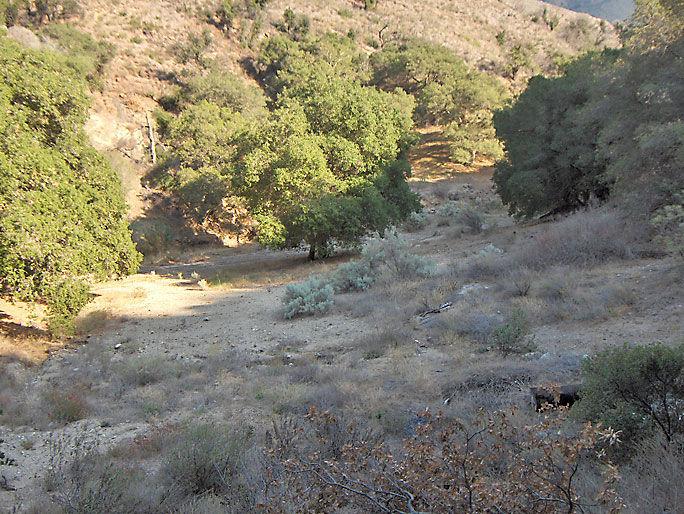
There was probably a jack plant somewhere in this area just south of the road at the bottom of Elsmere Canyon (view looking northeast taken on 10/13/2007)
Based on the physical and the photo evidence, I believe that a jack plant (also called a pump house) must have been located somewhere in the above picture. That area is at the base of a wide ravine (at least at the mouth) from the southwest that meets Elsmere creek here. There are jacklines, or strong evidence of jacklines, on both ridges of the ravine. The eastern ridge was the location of Elsmere 5, Elsmere 9, and Elsmere 18 (these being oil well locations - see Oil Well Locations Page). On the western ridge are five jackline supports and a jackline that comes down from the top of the canyon. At the top of the canyon looking down were Elsmere 15 and Elsmere 20 with Elsmere 10 nearby. Up the middle of the ravine was Elsmere 6. Elsmere 7 was located a couple of hundred feet to the wast almost at the canyon bottom. Elsmere 2 was located on the other side of the creek less than 100 feet from my postulated jack plant. Elsmere 13 was located to the east of Elsmere 5. Elsmere 16 was located south of, and above, 13. The following pictures show the physical evidence that led me to the conclusion that there was a jack plant here. Considering the small production of each well, Standard would have wanted to keep the number of central power units to a minimum to save on costs.
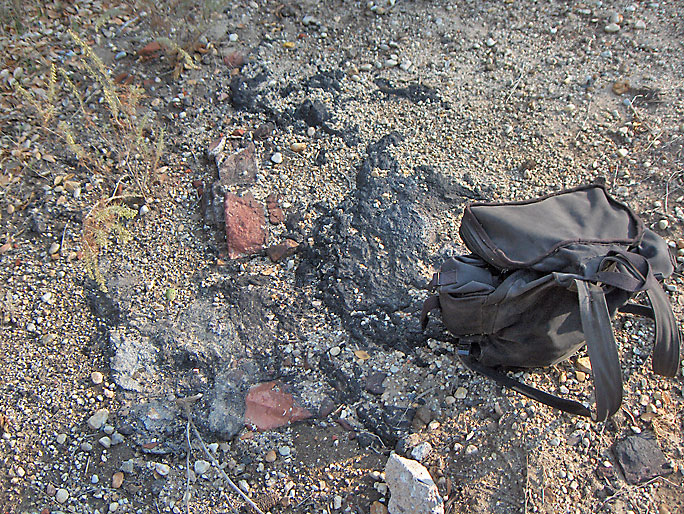
Could this have been where the jack plant was located? It would have been powered by a steam engine probably laying on a brick base. This spot is just southwest of the big tree in the middle of the first picture. (Photo taken on 10/13/2007)
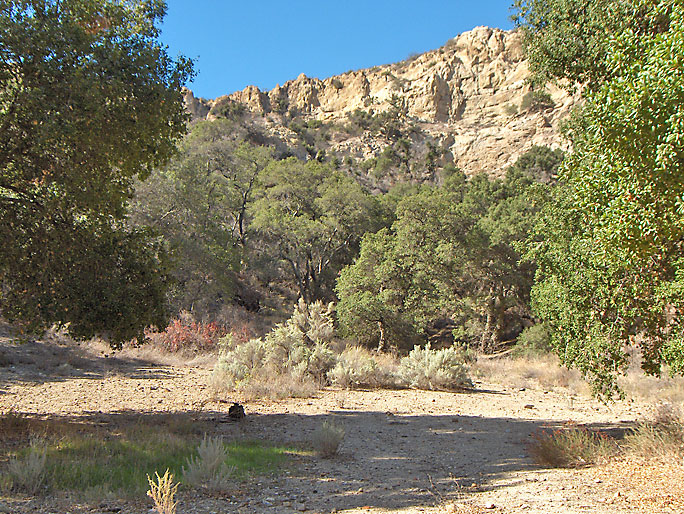
Here is the postulated jack plant site near my backpack looking southwest from the road. (10/20/2007)

Just below the Elsmere 5 site is this tall wooden post. This would have been a support for the jackline. (10/13/2007)
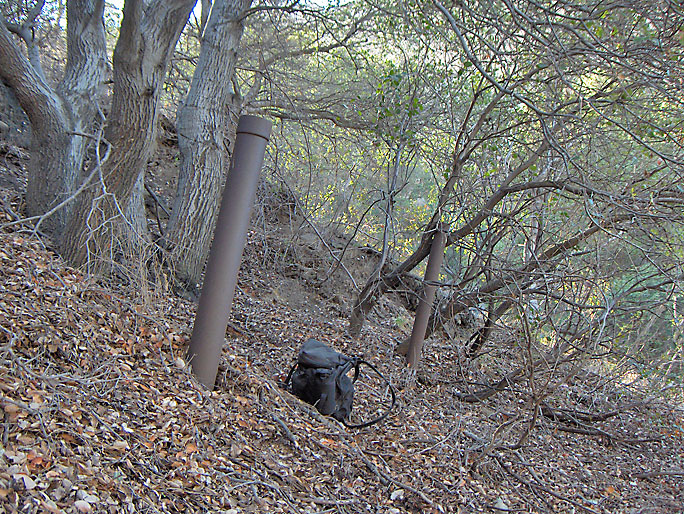
In a straight line about 50 feet below the wooden post are these pipes that could easily have been used to support a jackline. Below these pipes is the open area where the plant would have been located. (10/13/2007)
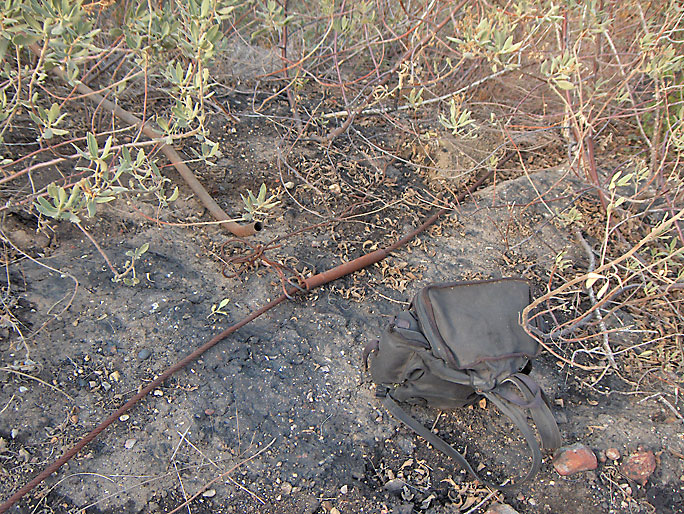
Below Elsmere 9 is this area about 20x20 feet covered with petroleum. There is also this jackline with splice and a pipe laying on the ground. The actual jackline support structure could have been a wooden post that has long since burned away. (10/13/2007)
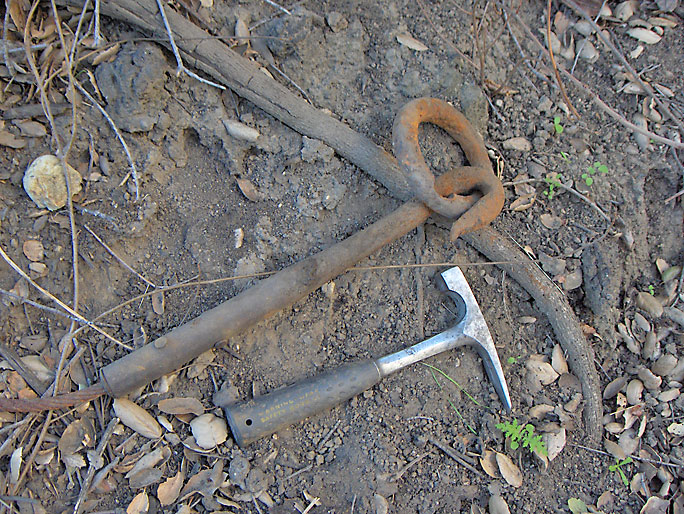
Farther down from the above picture is the end of the jackline with a hook and metal ring. The ring would connect to another jackline that would travel towards the jack plant. (10/20/2007)

Looking down (north) from Elsmere 18 is this jackline that seems to be laying in a man-made notch cut in the side of a steep cliff to the left that you can't see in the picture. There are also a couple of loose pipes in the notch. Elsmere 18 is high up the east ridge above Elsmere 9 which is above Elsmere 5. Old roads go to all three sites. (10/13/2007)
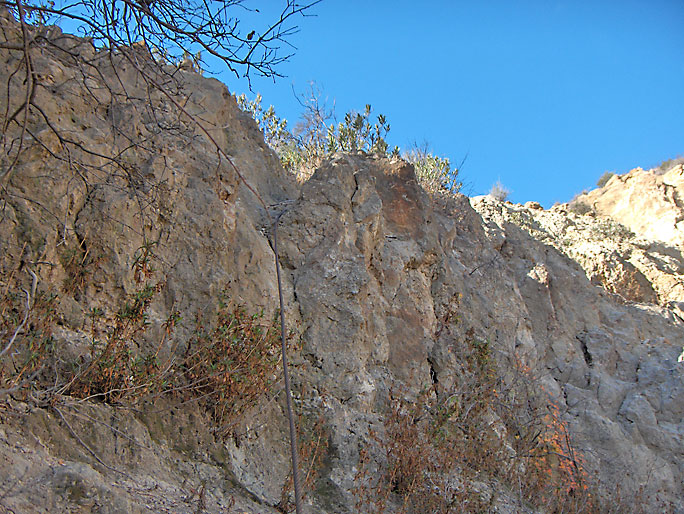
After some difficult climbing, I reached the end of the notch with the jackline heading down the side of the canyon. The canyon is quite steep in this area. (10/20/2007)
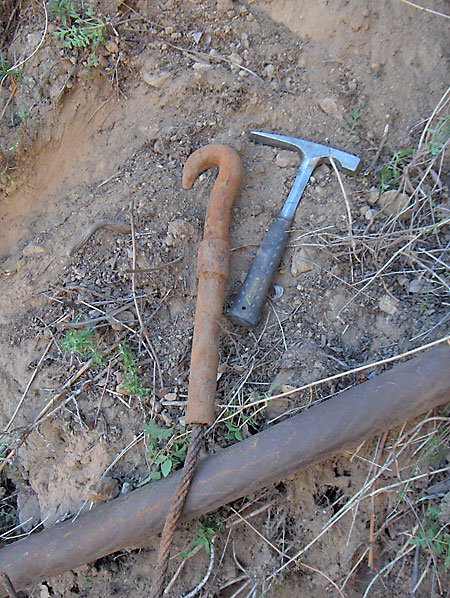
Near, and below, the above picture is the end of the jackline with a hook on it. There is also about a 20 foot long piece of pipe laying close by. (10/20/2007)

About 50 feet directly below the above picture is this 10 foot long wooden post that had obviously fallen from above. You can see the steepness of the canyon here. The post must have been part of a support structure for the jackline. There is a lot of almost leafless poison oak around here. (10/20/2007)
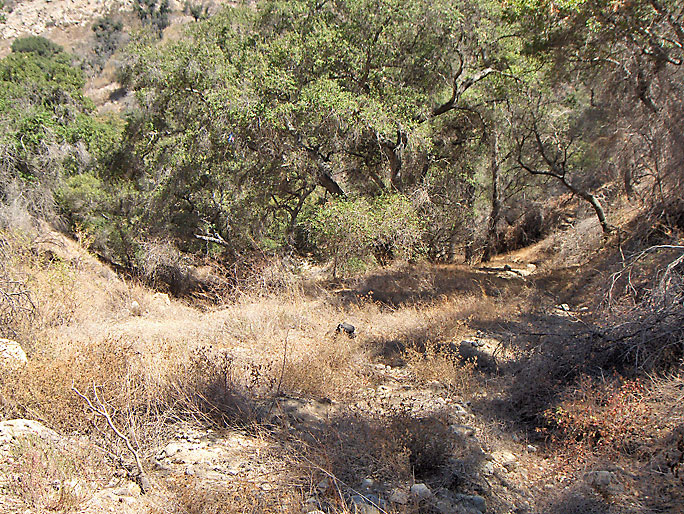
This is the Elsmere 6 site in the middle of the ravine up from (southwest of) the postulated jack plant. Due to the amount of sediments that have washed down from above this site over the years, there is no physical evidence that a jack line existed here. However, if there was a jack plant and this well was active at the time, then there is no reason not to believe that a jackline was used. It would have been no more than 300 feet in a straight line from here to the plant. (9/15/2007)
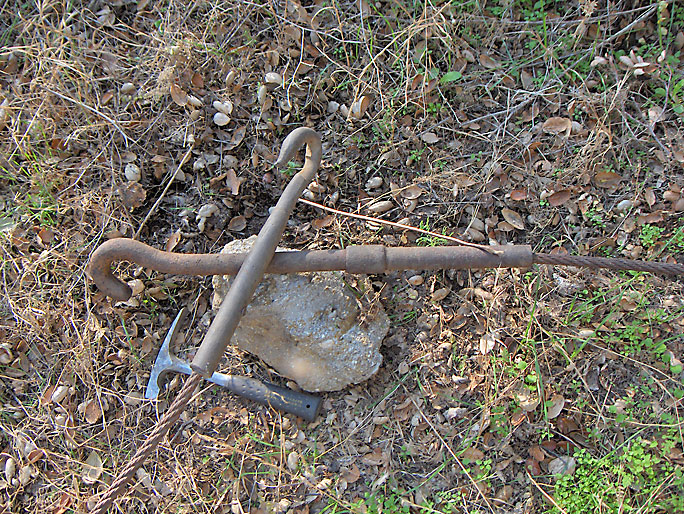
Near the mouth of the ravine, above the jack plant site, I found these two separate jacklines with hooks on their ends. These lines could have come from either Elsmere 6, 9, and/or 18. (10/20/2007)
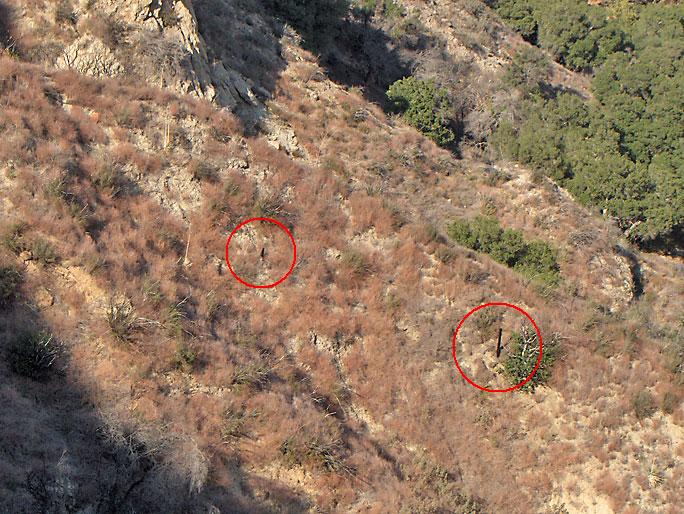
On the west ridge there are 4 wooden posts (or what's left of them). This picture was taken from the east ridge showing two of them. These posts would have been used to support a jackline. (10/13/2007)
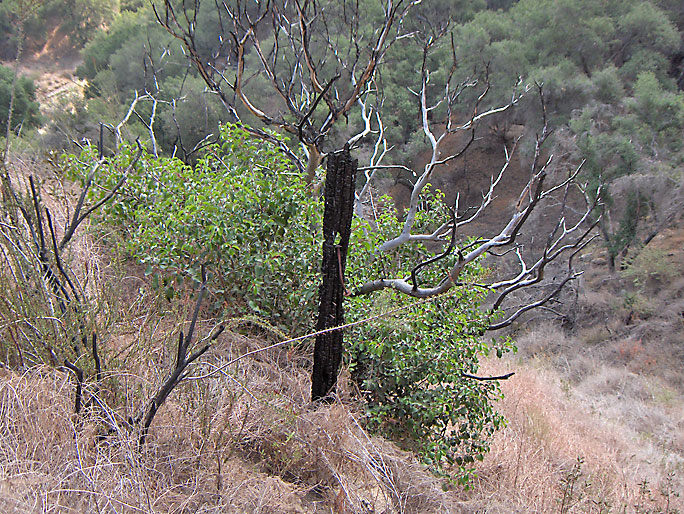
Here is the taller post from the above picture. An old bolt is all that is left of any hardware. (9/29/2007)
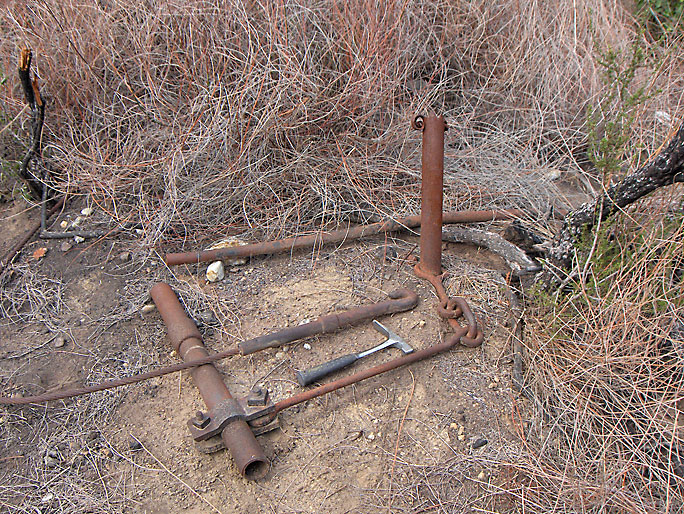
Above the shorter post in the above picture, near the base of the cliff to the top of the canyon, lies this hardware, including a jackline with a hook on the end. (9/29/2007)
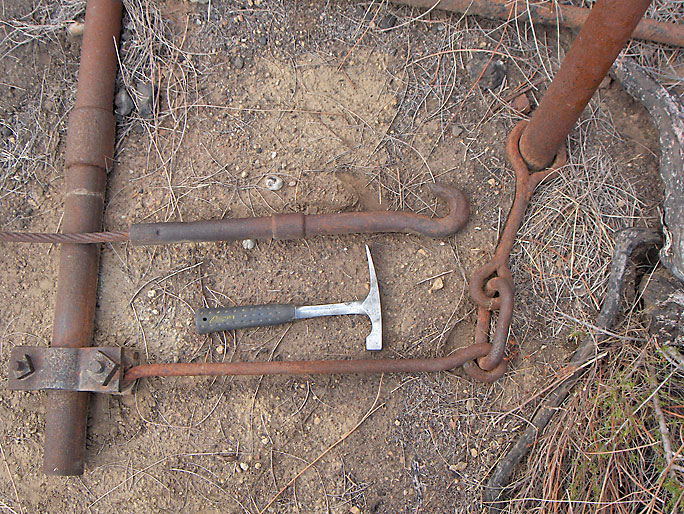
Here is a close up of the above hardware. I don't know how it all went together. (9/29/2007)
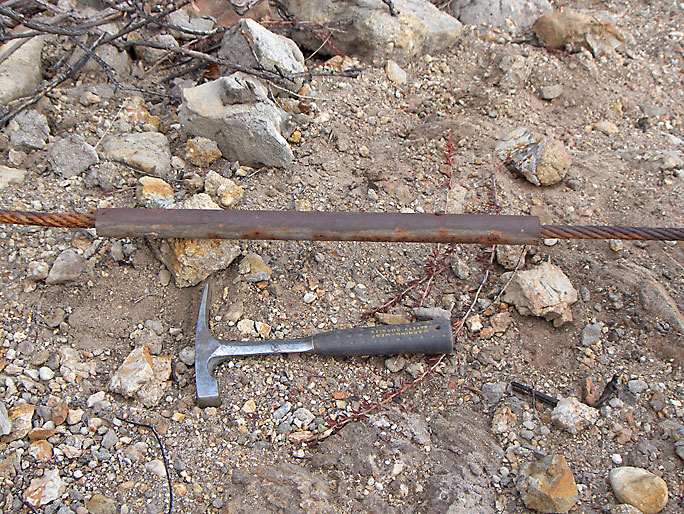
If you follow the jackline closer to the cliff face, you come to this splice. (9/29/2007)
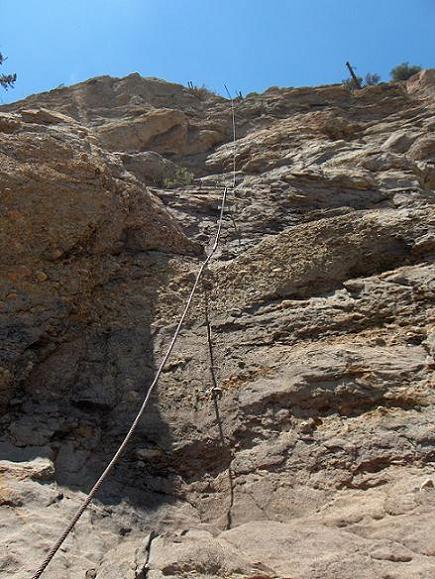
Looking up the face of the cliff you can see the same jackline. Near the top you can just make out some supports. On top of the cliff is the site of Elsmere 15, Elsmere 20, with Elsmere 10 nearby. At first it seemed to me that there was a jack plant at the top of the cliff but which wells would it have powered? There were no wells on the west ridge line from the top of the cliff to the bottom of the canyon so why would there be a jackline there? However, after locating the evidence near the other well sites it became clear that the plant was at the bottom powering at least one well at the top (either 15, 20, or 10). (7/21/2007)
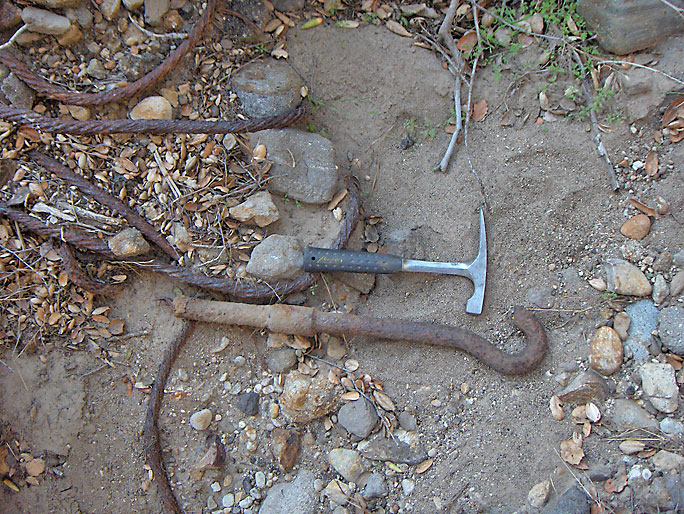
Here is a jackline hook just below the site of Elsmere 7 showing that it too was at one time pumped using a jackline. (10/20/2007)
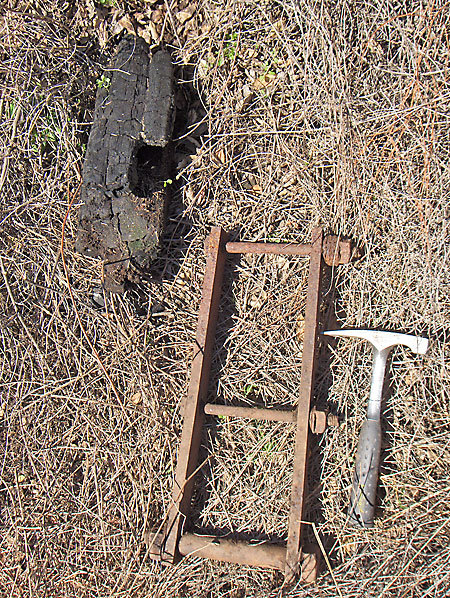
Here is a burned up post with hardware close to Elsmere 13 in the direction of Elsmere 5. This would appear to be part of a jackline support structure. Elsmere 16 is up from Elsmere 13. (1/1/2008)
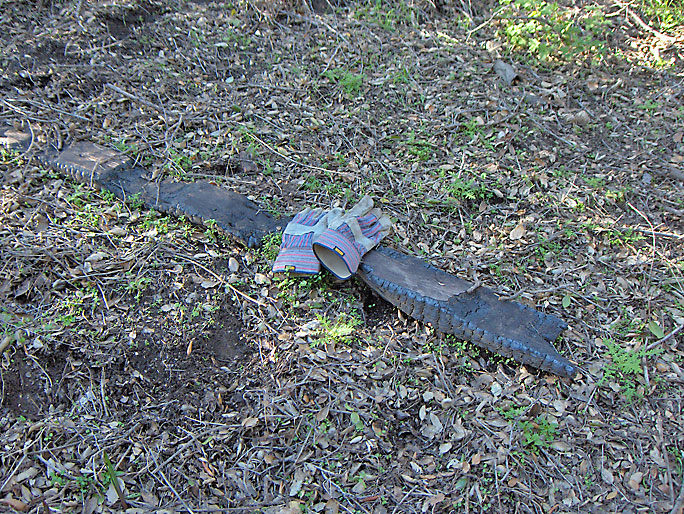
Here is a another burned up post between Elsmere 13 closer to Elsmere 5. This would also appear to be part of a jackline support structure. (1/1/2008)

Here is the area in 1905 from Arnold's photograph. It shows most of the west ridge but the wrong side of the east ridge. Considering the photo was taken over 100 years ago, it's pretty amazing that so much detail can be seen when it is blown up. All the derricks in the photo are numbered (Elsmere 5, Elsmere 6, etc.)

Here is the bottom part of the photo blown up. There appears to be a set of jackline support poles (red arrows) running up the west ridge. Two of these posts match the position of the two burned up posts from previous photos. There also seems to be some supports on the east ridge. There also appears to be a post between Elsmere 5 and Elsmere 13 (out of the picture to the left). The two derricks visible are marked with blue arrows.

Here is the middle part of the photo blown up. Besides the posts there also appears to be jacklines at the bottom of the cliff (green arrows).

Here is the top part of the photo blown up showing Elsmere 15 on the left and Elsmere 20 on the right. Elsmere 10 would be out of the photo behind 15. The structure with the black arrow is where the cable(s) from the bottom would have come up to. If you look down from that position today you can still a support structure about 50 feet down the cliff face. I can also see what may be a post between this structure and Elsmere 15, although I can't be certain.
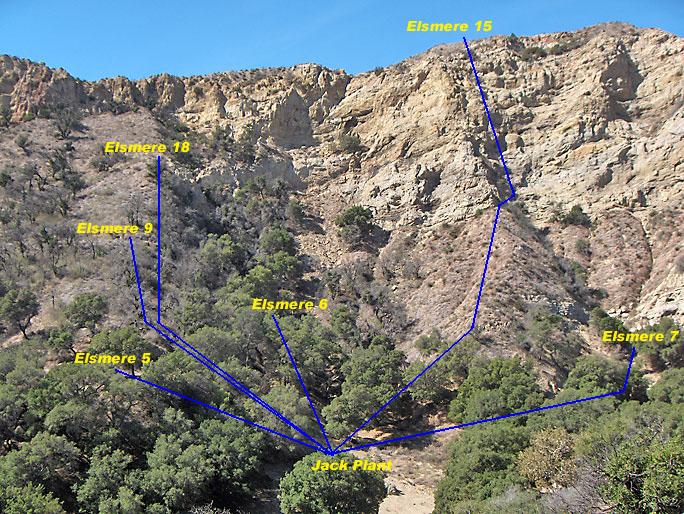
Here is my guess how the whole area was set up with a central power unit at a jack plant providing the power to the pumps at the well sites. Elsmere 2 (not shown on photo) is located across the creek bed out of the picture. There is no evidence that it was connected to the jack plant, but if it was still active at the time, then it should have been. There is also enough evidence to say that Elsmere 13 or 16 (also not shown) may have been part of this jackline setup. It is also probably that Elsmere 10, 15 and/or 20 were also hooked up to the plant. This would have been an impressive setup. The pumps at each well must have had counterweights to provide for the downward stroke of the pump and for keeping the jacklines taut, with the centrol power providing the power for the upstroke. (10/20/2007)
However, there is a big problem with this setup. The central power unit would not be in balance. For every jackline going to a well, there should be a counter balance, either another line to a well or a counterweight. With this setup, there would have to be a lot of counterweights. There may also have been more that one jack plants here.



























